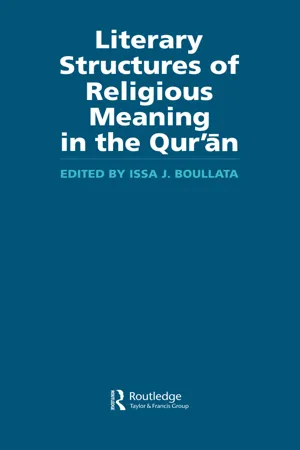![]()
PART I
FORM, MEANING, AND TEXTUAL STRUCTURE IN THE QUR'ĀN
![]()
Chapter 1
A Literary Approach to the Hymnic Sūras of the Qur'ān: Spirit, Gender, and Aural Intertextuality
Michael Sells
The hymnic sūras that are placed, for the most part, in the latter section of the written text of the Qur'ān are associated by tradition with the earliest period of Muhammad's prophecy.1 These are the passages that are learned first in Qur'ānic schools and frequently memorized. They contain, in brief, key aspects of Qur'ānic spirituality and theology. And they have attracted both strong aesthetic praise and strong aesthetic disapprobation from Western scholars. This essay constitutes a literary exploration of the early hymnic sūras, with special attention to Sūrat al-Zalzala (The Quaking, Q. 99) and Sūrat al-Shams (The Sun, Q. 91).2 The essay will range over the early Meccan sūras as a whole and at times will bring in aspects of other Qur'ānic passages to reinforce certain points. The focus is upon aural intertextuality as a key to literary effect. The thematic area that links these passages together most closely is the Qur'ānic conception of spirit.
In framing the issue in this manner, I use a word, spirit, from everyday language but also at the heart of the world's religious traditions. Among the many common meanings of the word “spirit” are: “an animating or vital principle”; “a supernatural being”; “a temper or disposition, especially when vigorous or animated”; “the immaterial intelligent or sentient part of a person” and “an inclination, tendency, mood.”3 The English word derives from the Latin spirare (to blow, breathe) and the English inspiration means literally a “breathing into.” There is no doubt that Qur'ānic recitation is based on breath patterns and has an effect of slowing and modulating the breathing. Modulation of breathing is an aspect of almost all meditative traditions, and Qur'ānic reciters are trained rigorously in breath control.
Beyond the effects of breathing and on breathing, there is a quality to the sound of the Qur'ān which anyone familiar with it in Arabic can recognize. Qur'ānic commentators have discussed the power and beauty
of this sound, what they call the
nam of the Qur'ān — the composition, or more loosely but perhaps more richly translated, the Qur'ānic “voice.” In turn, the concept of
nam is one of the key aspects of the science of analyzing
i'jāz al-Qur'ān (the inimitability of the Qur'ān) which is a standard feature of Qur'ānic commentary. Yet, while a rich history of testimonies exists regarding the power and beauty of the Qur'ānic voice, few explanations have been offered for how that voice works in relationship to the sound of the Qur'ān.
4 Here I will discuss the elusive issue of the relationship of sound to meaning in the Qur'ān by focusing upon the Qur'ānic understanding of spirit
(rū), a word that in Arabic as well is related to words for breath. While one could attempt to define the spirit as a particular being — as Gabriel, or another great angel, or yet another delimited entity,
5 the Qur'ānic language of spirit is most powerfully heard, through aural intertextuality, when the boundary between seemingly known and discrete entities is broken down.
The aural intertextuality of the Qur'ān is based upon the sound figure. This figure is particularly subtle in that it is developed within particular sūras (intratextually), but also across sūras that might be widely separated in the written version of the Qur'ān (intertextually). The Qur'ānic sound figures occur in connection with three moments: prophecy, creation, and the day of reckoning. These are boundary moments, points of contact between the eternal and the temporal realm, in which the structures of language (with temporality built into them) are transformed through contact with a realm beyond temporality; a transformation that manifests itself in the deeper sound figures. In each moment, the Qur'ān invokes the spirit
(rū).6In temporal sequence the three moments are separate.7 But the three moments are embedded, rhetorically and acoustically, within one another. Passages which may be separate in the written version of the Qur'ān echo, allude to, or offer variations of one another in a manner that ties them together. In a tradition as deeply oral and recitative as that of the Qur'ān, in which people have heard these passages recited thousands of times, one text will provoke the reader — through a sound figure shared with a passage from a different part of the written Qur'ān — into hearing the second passage as an undertone. As the various passages on each boundary moment weave themselves into one another through sound figures, the three boundary moments are brought into more intimate connection. The Qur'ānic references to spirit occur at center points or matrices of such inter-embedding.
Gender is a vital aspect of Qur'ānic sound figures and the Qur'ānic passages on spirit. Like all sacred texts of the classical period of religious revelations, the Qur'ān was revealed in a society in which the public voice of leadership was largely male, and thus the social context of the revelation, as with the Bible or the Vedas, was largely a male domain. Yet the gender dynamic within the Qur'ān is one of extraordinary...




